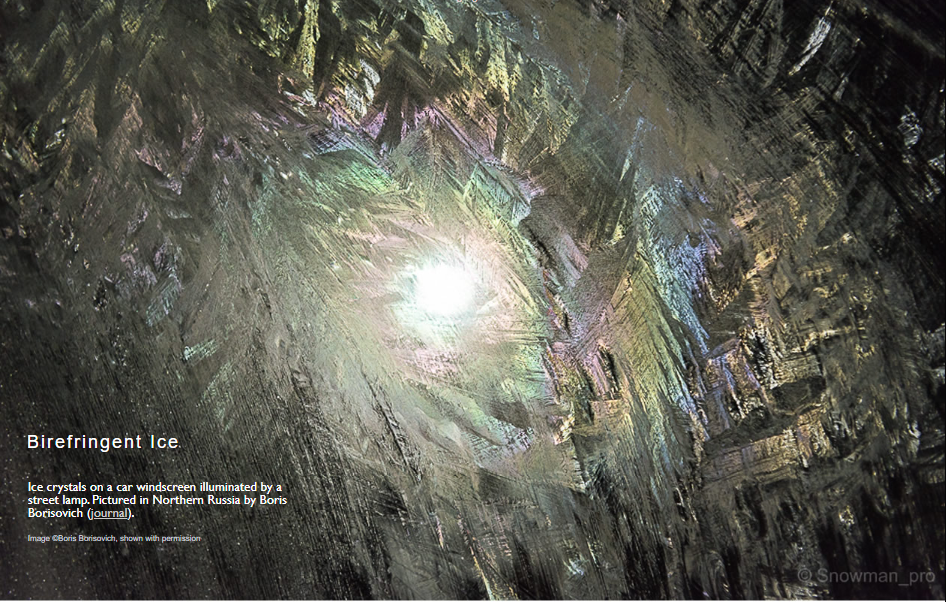Birefringent Ice
Birefringent Ice: Unveiling the Optical Marvels of Ice Crystals
Ice, with its open hexagonal structure, holds a significant role in our existence. Its unique properties, including birefringence, contribute to various atmospheric optical phenomena that captivate our senses. In this article, we will delve into the captivating world of birefringent ice, exploring how its anisotropic nature leads to mesmerizing displays of color and light.
An ice crystal's behavior varies depending on its direction, rendering it anisotropic. As a result, when light passes through the crystal, it refracts differently based on its path. This refraction causes unpolarized light to split into two polarized components, each traveling in slightly different directions within the crystal. These components give rise to an intriguing phenomenon: the overlapping and interference of waves.
When the waves of the refracted polarized components overlap and interfere, a fascinating effect occurs: the manifestation of birefringent colors. These colors are wavelength-dependent, meaning they exhibit different hues based on the characteristics of the incident light. This captivating interplay of light and ice crystals is responsible for a myriad of atmospheric optical displays that adorn our skies.
To fully appreciate the wonders of birefringent ice, it is essential to understand its impact on various atmospheric phenomena. Here are some notable occurrences where birefringent ice crystals play a crucial role:
-
Halos: Ice crystals in the atmosphere can create a halo around the Sun or Moon. These halos are formed when light passes through the crystals and undergoes refraction, resulting in an exquisite ring of colors encircling the celestial body.
-
Sun Dogs: Also known as parhelia, sun dogs are bright spots that appear on either side of the Sun. These optical marvels are caused by the refraction and reflection of sunlight by birefringent ice crystals suspended in the atmosphere.
-
Circumzenithal Arcs: This atmospheric phenomenon showcases a vibrant arc of colors positioned above the Sun. It occurs when sunlight interacts with horizontally oriented ice crystals, creating a spectacle of vivid hues against the backdrop of the sky.
-
Diamond Dust: A mesmerizing display of tiny ice crystals suspended in the air, diamond dust forms on cold, clear days. These crystals scatter sunlight, producing a shimmering effect that resembles a field of glittering diamonds.
-
Light Pillars: When light interacts with flat, plate-like ice crystals near the ground, it can create vertical columns of light known as light pillars. These pillars extend upward, showcasing an ethereal glow that adds an enchanting touch to nighttime landscapes.
The intricate relationship between birefringent ice crystals and light opens up a world of optical wonders for us to explore. It is through the interaction of light with these crystals that we are able to witness the breathtaking displays that grace our skies.
As we continue to study and unravel the mysteries of atmospheric optics, the role of birefringent ice remains a fascinating subject. By understanding how these crystals manipulate light, we gain insight into the intricate workings of our atmosphere and the captivating beauty that surrounds us.
In conclusion, birefringent ice crystals possess a unique anisotropic nature that contributes to the mesmerizing optical phenomena we observe in the atmosphere. The splitting and overlapping of polarized components within these crystals give rise to an array of birefringent colors, creating stunning displays such as halos, sun dogs, circumzenithal arcs, diamond dust, and light pillars. Through further exploration and study, we can deepen our understanding of these phenomena and appreciate the intricate relationship between light and ice crystals that continues to captivate our imagination.

Birefringent IcetopticsAHighlightsAtoptics Highlights - Optics Picture of the Day - OPOD - Atmospheric Optics Ice crystals on a car windscreen illuminated by a street lamp. Pictured in Northern Russia by Boris Borisovich (journal).
Image ©Boris Borisovich, shown with permission
Ice has a rather open hexagonal structure. We can thank that for our existence for otherwise ice would not float on water and Earth's climate would be quite different.
An ice crystal's properties depend on direction. It is anisotropic. As a result light refracts differently depending its direction through the crystal. Unpolarised light splits into two polarised components travelling in slightly different directions.
Waves of the differently refracted polarised components overlap and interfere. The effect is wavelength dependent and so we see birefringent colours.
Note: this article has been automatically converted from the old site and may not appear as intended. You can find the original article here.
Reference Atmospheric Optics
If you use any of the definitions, information, or data presented on Atmospheric Optics, please copy the link or reference below to properly credit us as the reference source. Thank you!
-
<a href="https://atoptics.co.uk/blog/birefringent-ice/">Birefringent Ice </a>
-
"Birefringent Ice ". Atmospheric Optics. Accessed on April 16, 2024. https://atoptics.co.uk/blog/birefringent-ice/.
-
"Birefringent Ice ". Atmospheric Optics, https://atoptics.co.uk/blog/birefringent-ice/. Accessed 16 April, 2024
-
Birefringent Ice . Atmospheric Optics. Retrieved from https://atoptics.co.uk/blog/birefringent-ice/.